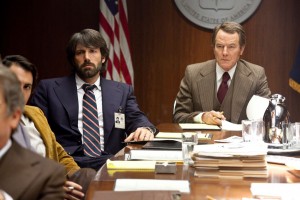 The movie within the movie, an outlandish space fantasy possibly named “Argo” for Jason’s vessel in the ancient Greek myth, may be more believable than the true and recently declassified story that surrounds it. In 1979, when American State Department employees were taken hostage in Iran, six escaped and were hidden by the Canadian ambassador. A CIA “exfiltration” expert who specializes in getting people out of difficult situations, rescued them by disguising them as members of a Canadian film crew, scouting locations for a fictitious Hollywood movie called “Argo.”
The movie within the movie, an outlandish space fantasy possibly named “Argo” for Jason’s vessel in the ancient Greek myth, may be more believable than the true and recently declassified story that surrounds it. In 1979, when American State Department employees were taken hostage in Iran, six escaped and were hidden by the Canadian ambassador. A CIA “exfiltration” expert who specializes in getting people out of difficult situations, rescued them by disguising them as members of a Canadian film crew, scouting locations for a fictitious Hollywood movie called “Argo.”
It is like an episode of the television series “Mission: Impossible” except that (1) it really happened and (2) it was much, much harder. Unlike “Mission: Impossible,” the people creating an elaborate false reality in order to fool the other side had to work with civilians. And they had to navigate a lot of bureaucratic, diplomatic, and national-security-related internal conflicts in a volatile environment with limited sharing of information. James Bond has something more valuable than a license to kill. He has a license to pretty much do whatever he wants with M ready to stand behind him. But Tony Mendez (played by director Ben Affleck) has to make a lot of literally life-or-death decisions very quickly and yet is still subject to oversight by layers of people with different priorities and points of view.
Affleck, following “The Town” and “Gone Baby Gone” (and a screenwriting Oscar for “Good Will Hunting”) is no longer one of Hollywood’s most promising new directors — he has arrived. This film works on every level. Even though we know the Americans were rescued (Canada’s embassy was given a prominent location near the White House in gratitude for their efforts), the tension is ferocious. The scenes in Hollywood, with John Goodman and a sure-to-be-nominated for a third Oscar Alan Arkin are as sharp and witty, recalling “The Producers” and “Get Shorty.” But rather than an easy way to provide contrast or comic relief, Affleck and first-time screenwriter Chris Terrio (based on an article in Wired Magazine) use those scenes to provide context, along with some tang and bite. One masterful section of the film intercuts the two stories as the Hollywood group set up shop, secure the rights to the screenplay, and put together a staged reading to get publicity to demonstrate their bona fides while the six Americans are trapped and the exfiltration mission gets underway. There are a lot of similarities — both sides deal in illusion, and not just the illusion of the sci-fi fantasy film they are pretending to make. The constant lying about the project comes naturally to Arkin’s character, an old-time Hollywood guy who has seen it all and who himself has no illusions about the integrity and loyalty of those around him. He says, “You’re worried about the Ayatollah. Try the WGA.”
Affleck locates the film in its era with hair and clothes that evoke the time period without exaggeration or ridicule, not easy to do with 70’s styles. He even used 70’s era film stock and borrowed some of the staging from movies of the era like “All the President’s Men,” and the opening titles are in a 70’s font. But the film also has some important insights about what happened and about our own time, reflected in the conflicts of three decades ago. It begins with a brief description of the events leading to the hostage crisis, emphasizing America’s support (to benefit the oil companies) of the Shah’s brutal regime, told somewhat differently than it would have been in 1979.
“You don’t have a better bad idea than this?” a State Department official asks the CIA. “This is the best bad idea we have,” is the reply from Jack O’Donnell (Bryan Cranston). They can’t fake any of the usual identities for the Americans because they are too easy to disprove. The normal reasons for foreigners to be abroad — teaching, studying, aid — are not plausible. Only something completely outrageous could be true. And it turns out that Iranians are as in love with Hollywood movies as everyone else. This one is a good reminder of why we all feel that way.
Parents should know that this film includes scenes of mob violence, hostages, references to terrorism, characters in peril, tense confrontations, alcohol, a lot of smoking, and very strong language.
Family discussion: Why did the Canadians take in the Americans? Why did Mendez defy his orders? What would you do if someone approached you the way Mendez approached the Hollywood insiders?
If you like this, try: “Charlie Wilson’s War”

